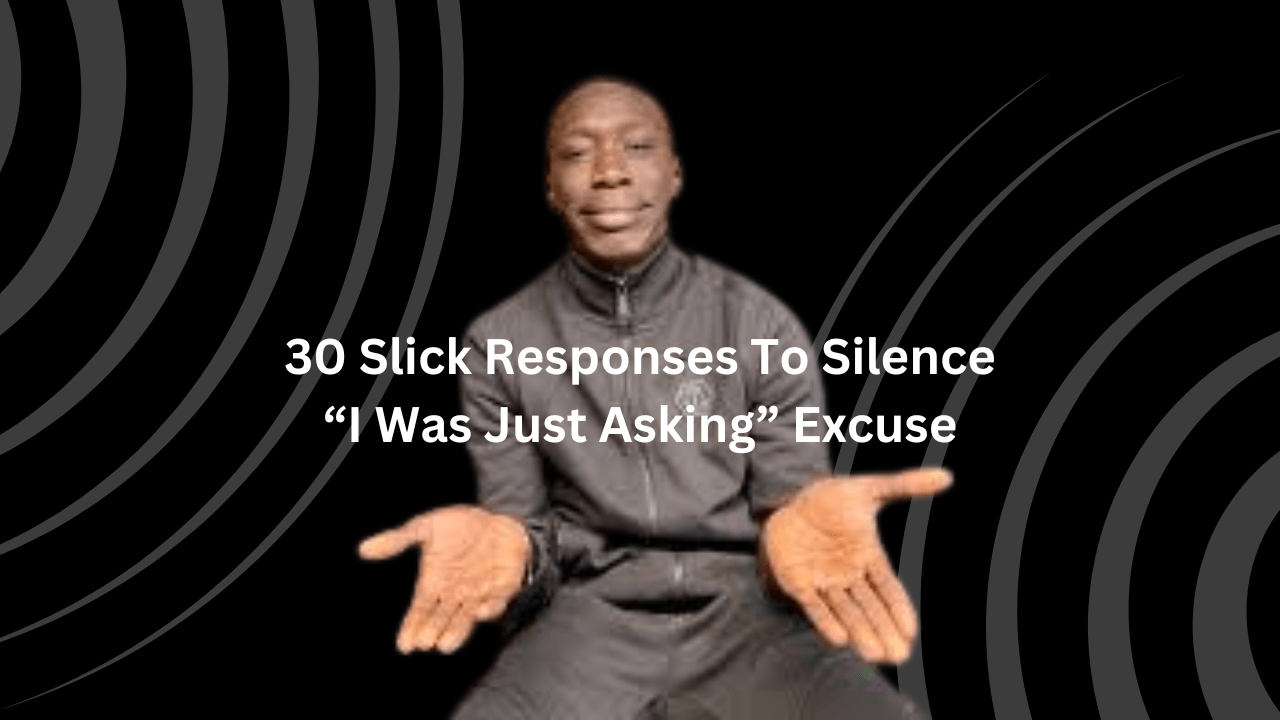In the vast landscape of communication, there are moments when a simple sound carries a world of meaning. “Pfft” is one such utterance, often deployed to convey dismissal, disbelief, or disdain. In this article, we delve into the nuances of “pfft” and equip you with effective strategies to respond gracefully and assertively in various contexts.
Understanding “Pfft”: What Does It Mean?
“Pfft” is an onomatopoeic word that mimics the sound of air being expelled forcefully and abruptly. It’s typically used in informal conversations or written communication to express skepticism, disregard, or a lack of interest. When someone responds with a “pfft,” they may be signaling that they find your statement unconvincing, trivial, or unworthy of serious consideration.
Check this Post also: 30 Best Ways to Respond to “TFTI”
Common Scenarios Where “Pfft” Arises:
Disagreements: When presenting an idea or argument, you might encounter a “pfft” in response, indicating disagreement or skepticism.
Dismissiveness: In casual conversations or debates, a “pfft” may be employed to dismiss someone’s opinion or viewpoint as insignificant.
Expressing Disbelief: Upon hearing something surprising or implausible, people often resort to a “pfft” to convey disbelief or incredulity.
Effective Strategies for Responding to “Pfft”:
“I sense some skepticism there. Let’s delve deeper into this.”
This response acknowledges the presence of skepticism in the conversation, indicating that the speaker has picked up on the doubt or disbelief conveyed by the “pfft.” By suggesting to delve deeper, the speaker invites further exploration into the reasons behind the skepticism, aiming to address any concerns or reservations the other person may have. This approach fosters open dialogue and encourages a deeper understanding of each other’s perspectives.
“Interesting reaction. Care to share your thoughts?”
With this response, the speaker acknowledges the reaction as interesting, indicating a genuine curiosity to understand the other person’s thoughts and feelings behind the “pfft.” By inviting the other person to share their thoughts, the speaker creates an opportunity for open communication and encourages the expression of opinions or concerns that may have led to the reaction. This approach promotes mutual respect and fosters a constructive exchange of ideas.
“Hmm, seems like you have a different perspective. I’m curious to hear more.”
This response acknowledges the existence of a differing perspective implied by the “pfft” and expresses genuine curiosity to learn more about it. By indicating a willingness to listen and understand, the speaker creates a conducive environment for open dialogue and mutual respect. This approach encourages the other person to share their viewpoint without judgment, fostering a deeper understanding of each other’s perspectives.
“Not convinced? Let’s explore this further.”
By acknowledging the lack of conviction implied by the “pfft,” this response suggests a proactive approach to address any doubts or reservations the other person may have. The speaker invites further exploration of the topic, indicating a willingness to engage in a meaningful discussion to clarify any misconceptions or uncertainties. This approach demonstrates openness to feedback and promotes constructive dialogue aimed at resolving differences.
“I see I haven’t quite convinced you yet. What aspect do you disagree with?”
This response acknowledges the speaker’s awareness of their failure to persuade the other person, as indicated by the “pfft.” By asking for clarification on specific points of disagreement, the speaker demonstrates a genuine interest in understanding the other person’s perspective and addressing any concerns or objections they may have. This approach fosters open communication and encourages a collaborative effort to find common ground.
“Fair enough. Let’s see if we can find some common ground.”
This response acknowledges the validity of the other person’s perspective, even if it differs from the speaker’s own viewpoint. By suggesting to find common ground, the speaker emphasizes the importance of mutual understanding and cooperation in resolving differences. This approach promotes a collaborative effort to bridge gaps in understanding and reach a mutually acceptable solution.
“You might have a point there. Can you elaborate?”
By acknowledging the possibility that the other person may have a valid point, this response demonstrates humility and openness to different perspectives. By inviting the other person to elaborate on their viewpoint, the speaker shows a genuine interest in understanding their perspective and encourages them to express their thoughts and concerns more fully. This approach fosters open dialogue and promotes mutual respect in communication.
“It seems my point didn’t quite land with you. Let me try explaining it differently.”
This response acknowledges the failure of the speaker’s point to resonate with the other person, as indicated by the “pfft.” By offering to rephrase or clarify their explanation, the speaker demonstrates a willingness to adapt their communication style to better convey their message. This approach reflects a commitment to effective communication and promotes a constructive exchange of ideas aimed at reaching mutual understanding.
“Looks like I’ve sparked some doubt. Let’s address that.”
By acknowledging the doubt or uncertainty sparked by the speaker’s statement, this response demonstrates empathy and a proactive approach to addressing concerns. By suggesting to address the doubt directly, the speaker creates an opportunity for open dialogue and constructive discussion aimed at resolving any misconceptions or uncertainties. This approach fosters trust and mutual respect in communication.
“Interesting reaction! Mind sharing what you find questionable?”
This response acknowledges the other person’s reaction as interesting and invites them to articulate the specific aspects of the conversation that they find questionable or problematic. By encouraging the other person to share their thoughts, the speaker demonstrates a genuine interest in understanding their perspective and fosters open communication. This approach promotes mutual respect and encourages a collaborative effort to address any concerns or objections raised.
“I understand if you’re hesitant. Let’s address any concerns you have.”
This response acknowledges the hesitancy implied by the “pfft” and expresses empathy towards the other person’s reservations. By suggesting to address any concerns they may have, the speaker demonstrates a willingness to listen and understand, fostering trust and openness in communication. This approach creates a supportive environment for discussing and resolving any issues or objections raised.
“Seems like you’re not entirely on board. Let’s see if we can bridge the gap.”
This response acknowledges the other person’s lack of enthusiasm or agreement, as indicated by the “pfft,” and suggests working together to overcome differences. By proposing to bridge the gap between their perspectives, the speaker emphasizes the importance of mutual understanding and cooperation in resolving conflicts. This approach promotes a collaborative effort to find common ground and reach a mutually acceptable solution.
“Not buying it? Let’s break it down further.”
By acknowledging the skepticism or disbelief implied by the “pfft,” this response suggests a proactive approach to addressing any doubts or reservations the other person may have. By proposing to break down the topic into smaller components, the speaker demonstrates a commitment to clarity and understanding, fostering open communication and constructive dialogue. This approach encourages mutual respect and promotes a collaborative effort to reach a shared understanding.
“I can see you’re not fully convinced. What can I clarify for you?”
This response acknowledges the lack of conviction indicated by the “pfft” and offers to provide clarification or additional information to address any doubts or uncertainties. By asking what they can clarify, the speaker demonstrates a willingness to listen and understand the other person’s concerns, fostering open communication and promoting mutual respect. This approach creates a supportive environment for discussing and resolving any issues or objections raised.
“A ‘pfft,’ huh? Let’s see if we can find some common ground.”
By acknowledging the dismissive tone of the “pfft,” this response suggests a proactive approach to finding common ground and resolving differences. By proposing to find common ground, the speaker emphasizes the importance of mutual understanding and cooperation in communication. This approach promotes a collaborative effort to bridge gaps in understanding and reach a mutually acceptable solution.
“I sense some skepticism. Let’s discuss.”
This response acknowledges the skepticism implied by the “pfft” and suggests engaging in open discussion to address any doubts or reservations the other person may have. By inviting them to discuss their concerns, the speaker demonstrates a willingness to listen and understand their perspective, fostering open communication and promoting mutual respect. This approach creates a supportive environment for discussing and resolving any issues or objections raised.
“I understand if you’re hesitant. Let’s address any doubts you have.”
This response acknowledges the hesitancy implied by the “pfft” and expresses empathy towards the other person’s reservations. By suggesting to address any doubts they may have, the speaker demonstrates a commitment to understanding and resolving their concerns, fostering trust and openness in communication. This approach creates a supportive environment for discussing and resolving any issues or objections raised.
“Hmm, seems like you’re not sold on that idea. Let’s explore why.”
By acknowledging the lack of enthusiasm or agreement indicated by the “pfft,” this response suggests a proactive approach to understanding and addressing the other person’s reservations. By proposing to explore the reasons behind their reluctance, the speaker demonstrates a willingness to listen and understand their perspective, fostering open communication and promoting mutual respect. This approach creates a supportive environment for discussing and resolving any issues or objections raised.
“Interesting reaction! What aspect are you questioning?”
This response acknowledges the other person’s reaction as interesting and invites them to specify which aspects of the conversation they find questionable or uncertain. By encouraging them to share their thoughts, the speaker demonstrates a genuine interest in understanding their perspective and fosters open communication. This approach promotes mutual respect and encourages a collaborative effort to address any concerns or objections raised.
“Fair enough. Let’s see if we can find some middle ground.”
This response acknowledges the fairness of the other person’s perspective, even if it differs from the speaker’s own viewpoint. By suggesting to find middle ground, the speaker emphasizes the importance of mutual understanding and cooperation in resolving differences. This approach promotes a collaborative effort to bridge gaps in understanding and reach a mutually acceptable solution.
Conclusion:
Responding to a “pfft” requires finesse and tact. By understanding the underlying meaning behind this dismissive sound and employing effective communication strategies, you can navigate conversations with confidence and grace. Whether it’s addressing disagreements, dispelling disbelief, or simply maintaining composure in the face of dismissal, mastering the art of responding to “pfft” is essential for effective communication in various social and professional settings.
Remember, communication is a two-way street, and acknowledging the perspectives of others while staying true to your own convictions is key to fostering meaningful dialogue and mutual understanding. So, the next time you encounter a “pfft,” embrace the opportunity to engage constructively and elevate the conversation to new heights.









